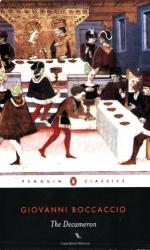|
This section contains 13,113 words (approx. 44 pages at 300 words per page) |

|
SOURCE: Scaglione, Aldo D. “The Decameron.” In Nature and Love in the Late Middle Ages, pp. 53-75. Berkeley: University of California Press, 1963.
In the following excerpt, Scaglione explores Boccaccio's attitude towards spiritual and sexual love as they are expressed in the Decameron.
The first question about a book concerns its form, and the Decameron is, in form, an unusually systematic collection of novellas. A good deal of realistic literature had developed in the Middle Ages within the framework of the short story, from the Latin forms (variously called exemplum, parabula, fabula, historia, legenda), to the French contes and fabliaux (fablel, fableau) and the Italian novella (conto). Of the literature that lies at the formal origin of the Decameron one must distinguish two types: firstly, the parable or tale with a moral (conte à queue, as the French used to call it), closest to the ecclesiastical milieu, frequently used by...
|
This section contains 13,113 words (approx. 44 pages at 300 words per page) |

|


